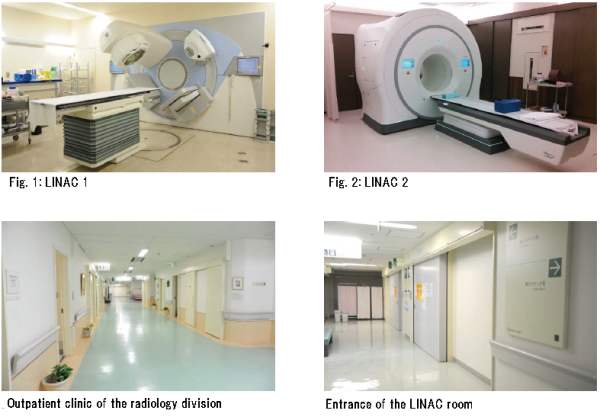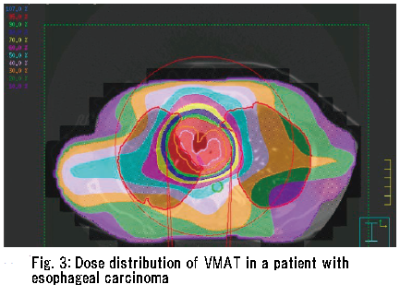Top > About Us > News Letter > LINAC in clinical practice
LINAC in clinical practice
Healthcare Programs Promoted at the University of Tokyo Hospital
Programs Currently Underway in Clinical Settings
Department of Radiology
Hideomi Yamashita (Lecturer)
1. Two types of LINACs (three in total) are installed in our division
Our division possesses three LINACs (linear accelerators) for external beam radiotherapy. The linear accelerator is the instrument most widely used to generate X-rays and electron beams in radiotherapy. It accelerates particles along a linear line to generate high-energy electrons. We have three LINACs: two LINACs 1 (Fig. 1) and one LINAC 2 (Fig. 2). The LINACs 1 (installed in January 2007) can be used to take CT images in order to adjust the patient's position on the treatment table. Before the start of every radiotherapy session, a CT image is taken to locate the accurate position of the target lesion, allowing the radiotherapy to be performed more accurately. This procedure is referred to as image-guided radiotherapy (IGRT), and is already covered by the National Health Insurance. A new LINAC version (the LINAC 2) was installed in October 2014. The latter has an additional function, in that the radiation port can rotate in a 360-degree circle around the anteroposterior axis of the patient while moving in a craniocaudal direction during the irradiation process. This makes it possible to irradiate patients in a more complex way than ever before.

2. Number of patients treated
Between January 2014 and December 2014, 741 new patients were treated in our radiotherapy division. This was almost the same as the number of new patients treated between January and December 2013 (764). The numbers of patients according to the primary area of focus were as follows: 56 in the brain and spinal cord, 115 in the head and neck (including the thyroid), 130 in the esophagus, 92 in the lung, 101 in the mammary gland, 73 in gynecological areas, and 102 in the prostate. As in many other institutions, the numbers of patients with prostatic and breast cancers were high. Furthermore, in our division, the numbers of new patients with esophageal and gynecological cancers were also notably high. For the treatment of breast cancer, 63 patients underwent radiotherapy after breast-conserving surgery, and 9 patients underwent radiotherapy after a mastectomy.
3. Intensity Modulated Radiation Therapy (IMRT) performed with all three LINACs
Overall, external beam radiotherapy has been performed in 753 cases, Intensity Modulated Radiation Therapy (IMRT) in 166 cases, and stereotactic radiotherapy (a form of external beam therapy with pinpoint accuracy) in 51 cases. The number of cases undergoing IMRT has markedly increased, from 6 cases in 2007, 33 cases in 2008, and 137 cases in 2013, to a higher number in 2015. IMRT is a new computer-aided technology that paints the radiation dose onto the tumor with pinpoint precision. In comparison with traditional radiotherapies, IMRT provides better tumor control and fewer adverse effects. It is being rapidly adopted as an alternative to traditional radiotherapies in the U.S. and Europe, and has also become much more prevalent in Japan. IMRT is useful in the treatment of prostatic cancer, as it avoids or reduces the exposure of the urinary bladder, which is just in front of the target, and of the rectum, which is at the rear of the target. IMRT has been reported to substantially reduce the incidence of adverse effects such as rectal hemorrhage in patients with prostatic cancer and of salivary gland disorders in patients with head and neck cancer, or to attenuate the severity of those symptoms when they occur. In our division, IMRT is performed with all three LINACs. In particular, the LINAC 2 is dedicated to IMRT.
4. Indications for IMRT are increasing
We started to perform IMRT in April 2003. In August 2008, Volumetric Modulated Arc Therapy (VMAT), which is currently becoming the main IMRT stream, began to be performed in clinical practice using the LINAC 1. As compared with usual IMRT, VMAT can shorten the duration of the therapy. This is expected to be effective in reducing organ movement and in improving the dose-rate effect. We initially performed IMRT for the treatment of prostatic and head and neck cancers only. However, the indications for IMAT were subsequently expanded, and IMRT is now used in radical chemo-radiation therapy for esophageal carcinoma (Fig. 3) and lung cancer, and in stereotactic radiotherapy for lung cancer and all post-cervical cancer resection surgery cases. In a clinical study, IMRT was performed with the LINAC 2 for total body irradiation in pre-transplant patients and for total skin electron irradiation in patients with skin malignant lymphoma.
We will continue to facilitate the development of radiation therapy using innovative instruments including LINACs as one of the main streams of cancer therapy.

